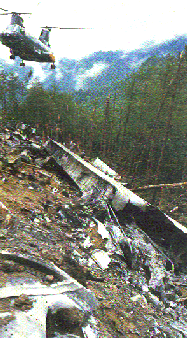![[Mt.Otsuka]](OTSUKA.gif)
Flight Route JAL 123
 This is not an accident investigation report.
This is not an accident investigation report.
Extracts from the CVR recorded conversation on the flight deck:
18.24 Bang heard from rear of aircraft Beep..Beep.. (cabin pressure warning horn)
Captain Takahama: (The captain called for; Emergency squawk 7700 on transponder)
Flight Engineer: "Hydraulic pressure down...amber light on...."
Captain Takahama: "Right turn....Right turn"
Flight Engineer: "I did..."
Captain Takahama: "Tokyo, JAL 123. Request for immed...e......trouble. Request return to
Haneda. Decend an maintain two two zero. Over."
Tokyo Control: "Roger, approved as you requested."
Captain Takahama: "Radar vector to Oshima, please."
Captain Takahama: "Hydro.....all no good."
Tokyo Control: "Fly heading zero none zero, radar vector Oshima."
Captain Takahama: "But, now uncontrol."
Tokyo control: "Uncontrol. Roger, understood."
18.28 Door five, right warning light illuminated, to indicate it was unlocked.
Flight Engineer: (reported after conversation, via plane intercom, with flight attendant)
"Captain, door five right window. Emergency descent may be advisable.
Shall we use our oxygen masks, too?"
Captain Takahama: "Yes, that's better"
Tokyo control: "You are now 72 miles from Nagoya; can you land at Nagoya?"
Captain Takahama: "Request return to Haneda"
18.33 At this stage the engines were still operational, however all flying
controls and hydraulic systems were inoperative. The aircraft was experiencing
a condition called "Dutch roll". The off duty stewardess Yumi Ochiai, one
of the four survivors, who had been sitting in the rear section of the plane
recalled how the 747 began to "hira-hira", fall like a leaf.
The pilots attempted to direct the aircraft using the engines alone, and
lowered the landing gear to try to help control the speed and stability
of the plane.
18.41 At 22,000ft complete control was lost and the aircraft banked in a
full circle 2.5 miles in radius over Otsuki City.
18.47
Tokyo Control: "Can you control now"
Captain Takahama: "Uncontrollable"
Captain Takahama: "Hey, there's a mountain.
Captain Takahama: "Turn right. Up. We'll crash into a mountain"
The crew applied full power to climb but the aircraft began to pitch up and down wildly.
Then the speed began to drop rapidly down to 108kt.
Flight Engineer: "Shall I rev it up?"
Captain Takahama: "Rev up, Rev up..Oh no.....stall."
Captain Takahama: "Maximum power"
Flight Engineer: "We are gaining speed"
Captain Takahama: "Keep trying"
Captain Takahama: "The speed is 220kt."
Tokyo Approach: "JAL 123, your position five ah, five ah, 45 miles northwest of Haneda"
Captain Takahama: "Northwest of Haneda. Eh, how, how many miles?"
Tokyo Approach: "Yes, that's right. According to our radar it is 55 miles northwest, ah
25 miles west of Kumagaya. Roger, I will talk in Japanese. We are ready for your
approach any time. Also, Yokota landing is available. Let us know your intensions."
18.50 The aircraft was now decending the Captain tried to control the plane using
flaps and power.
Captain Takahama: "Flap set?"
First Officer: "Yes, flap ten"
Captain Takahama: "Nose up....Nose up......Nose up.
Captain Takahama: "Hey, hold the flap....ah, don't lower so much flap.
Flap up, flap up, flap up."
Captain Takahama: "Power, power....flaps."
First Officer: "It is up."
Captain Takahama: "Nose up......Nose up......POWER."
Audio Ground proximity warning system sounded (GPWS)
GPWS: "Pull up..Pull up...Pull up......"
The Boeing 747 SR crashed into the side of Mount Otsuka at a height of 4780ft
70 miles North West of Tokyo.
On the 13th August 1995, debris from the stricken airliner were found in Sagami Bay
including parts of the tail fin, lower rudder, panelling from the rear fuselage and
ducting from the auxiliary power unit.
Virtually half of the tail fin had detached in flight falling into the sea between
Oshima Island and the headland.
![[Mt.Otsuka]](OTSUKA.gif)